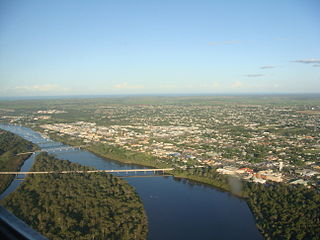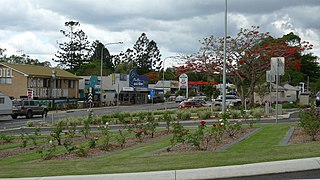
Bundaberg is a city in the Bundaberg Region, Wide Bay, Queensland, Australia, and is the tenth largest city in the state. It is a major centre of the Wide Bay–Burnett geographical region. The Bundaberg central business district is situated along the southern bank of the Burnett River, about 20 km (12 mi) from its mouth at Burnett Heads, and flows into the Coral Sea. The city is sited on a rich coastal plain, supporting one of the nation's most productive agricultural regions. The area of Bundaberg is the home of the Taribelang-Bunda, Goreng Goreng, Gurang, and Bailai peoples. Popular nicknames for Bundaberg include "Bundy", "Rum City", and "The 'Berg". The demonym of Bundaberg is Bundabergian. In the 2021 census, Bundaberg's urban area has a population of 73,747 people.

The Kabi Kabi people, also spelt Gubbi Gubbi, Gabi Gabi, and other variants, are an Aboriginal Australian people native to South Eastern Queensland. During the Australian frontier wars of the 19th century, there were several mass killings of Kabi Kabi people by settlers. They are now classified as one of several Murri language groups in Queensland. A 2024 determination granted non-exclusive native title rights over an 365,345-hectare (902,790-acre) area of land and waters on the Sunshine Coast.

Gin Gin is a rural town and locality in the Bundaberg Region, Queensland, Australia. In the 2021 census, the locality of Gin Gin had a population of 1,139 people.

William Forster was a pastoral squatter, colonial British politician, Premier of New South Wales from 27 October 1859 to 9 March 1860, and poet.

Burnett Heads is a coastal town and locality in the Bundaberg Region, Queensland, Australia. In the 2021 census, the locality of Burnett Heads had a population of 2,908 people.

Wallaville is a rural town and locality in the Bundaberg Region, Queensland, Australia. It is 372 kilometres (231 mi) north of the state capital, Brisbane and 43 kilometres (27 mi) south west of the regional centre of Bundaberg. In the 2021 census, the locality of Wallaville had a population of 363 people.

William Henry Walsh J.P. was an Australian pioneer pastoralist or squatter and politician in early Queensland. He was a Member of the New South Wales Legislative Assembly 1859-1859, Member of the Queensland Legislative Assembly 1865–1878, and a Member of the Queensland Legislative Council 1879–1888. He was the Queensland Minister of the Crown 1870–1873, Speaker in the Queensland Legislative Assembly from 6 January 1874 to 20 July 1876.

The Mount Perry Branch Railway is a closed railway line in Central Queensland, Australia. In 1869 copper was discovered at Mount Perry and the township grew rapidly. A railway to the coast was essential to provide cheap transport and make the mining of low percentage ore viable. Maryborough and Bundaberg vied for the opportunity to be the terminus and the latter city was successful.

Wide Bay–Burnett is a region of the Australian state of Queensland, located between 170–400 km (110–250 mi) north of the state capital, Brisbane. The area's population growth has exceeded the state average over the past 20 years, and it is forecast to grow to more than 430,000 by 2031. It is the subject of the Draft Wide Bay–Burnett Regional Plan, which aims to facilitate this growth while protecting over 90% of the region from urban development.

The 1936 Bundaberg distillery fire was a disaster in Bundaberg, Queensland, Australia.

South Kolan is a rural locality in the Bundaberg Region, Queensland, Australia. In the 2021 census, the locality of South Kolan had a population of 1,258 people.

Oakwood is a rural locality in the Bundaberg Region, Queensland, Australia. In the 2021 census, Oakwood had a population of 364 people.
Sharon is a rural locality in the Bundaberg Region, Queensland, Australia. In the 2021 census, Sharon had a population of 1,209 people.

Rubyanna is a rural locality in the Bundaberg Region, Queensland, Australia. In the 2021 census, Rubyanna had a population of 257 people.
Bungadoo is a rural locality in the Bundaberg Region, Queensland, Australia. The area was formerly known as Albionville. In the 2021 census, Bungadoo had a population of 342 people.
Morganville is a rural locality in the Bundaberg Region, Queensland, Australia.
Monduran is a rural locality in the Bundaberg Region, Queensland, Australia. In the 2021 census, Monduran had a population of 84 people.
Duingal is a locality in the Bundaberg Region, Queensland, Australia. In the 2021 census, Duingal had a population of 70 people.
Bundaberg–Gin Gin Road is a state-controlled district road in the Bundaberg region of Queensland, Australia. It runs from Bundaberg–Bargara Road in Bundaberg Central to the Bruce Highway in Gin Gin, a distance of 48.4 kilometres (30.1 mi). It is signed as State Route 3.













